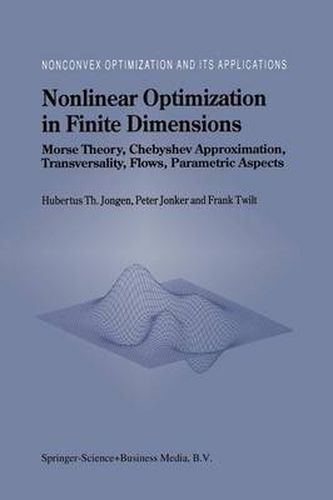Readings Newsletter
Become a Readings Member to make your shopping experience even easier.
Sign in or sign up for free!
You’re not far away from qualifying for FREE standard shipping within Australia
You’ve qualified for FREE standard shipping within Australia
The cart is loading…






This title is printed to order. This book may have been self-published. If so, we cannot guarantee the quality of the content. In the main most books will have gone through the editing process however some may not. We therefore suggest that you be aware of this before ordering this book. If in doubt check either the author or publisher’s details as we are unable to accept any returns unless they are faulty. Please contact us if you have any questions.
At the heart of the topology of global optimization lies Morse Theory: The study of the behaviour of lower level sets of functions as the level varies. Roughly speaking, the topology of lower level sets only may change when passing a level which corresponds to a stationary point (or Karush-Kuhn Tucker point). We study elements of Morse Theory, both in the unconstrained and constrained case. Special attention is paid to the degree of differentiabil ity of the functions under consideration. The reader will become motivated to discuss the possible shapes and forms of functions that may possibly arise within a given problem framework. In a separate chapter we show how certain ideas may be carried over to nonsmooth items, such as problems of Chebyshev approximation type. We made this choice in order to show that a good under standing of regular smooth problems may lead to a straightforward treatment of just continuous problems by means of suitable perturbation techniques, taking a priori nonsmoothness into account. Moreover, we make a focal point analysis in order to emphasize the difference between inner product norms and, for example, the maximum norm. Then, specific tools from algebraic topol ogy, in particular homology theory, are treated in some detail. However, this development is carried out only as far as it is needed to understand the relation between critical points of a function on a manifold with structured boundary. Then, we pay attention to three important subjects in nonlinear optimization.
$9.00 standard shipping within Australia
FREE standard shipping within Australia for orders over $100.00
Express & International shipping calculated at checkout
This title is printed to order. This book may have been self-published. If so, we cannot guarantee the quality of the content. In the main most books will have gone through the editing process however some may not. We therefore suggest that you be aware of this before ordering this book. If in doubt check either the author or publisher’s details as we are unable to accept any returns unless they are faulty. Please contact us if you have any questions.
At the heart of the topology of global optimization lies Morse Theory: The study of the behaviour of lower level sets of functions as the level varies. Roughly speaking, the topology of lower level sets only may change when passing a level which corresponds to a stationary point (or Karush-Kuhn Tucker point). We study elements of Morse Theory, both in the unconstrained and constrained case. Special attention is paid to the degree of differentiabil ity of the functions under consideration. The reader will become motivated to discuss the possible shapes and forms of functions that may possibly arise within a given problem framework. In a separate chapter we show how certain ideas may be carried over to nonsmooth items, such as problems of Chebyshev approximation type. We made this choice in order to show that a good under standing of regular smooth problems may lead to a straightforward treatment of just continuous problems by means of suitable perturbation techniques, taking a priori nonsmoothness into account. Moreover, we make a focal point analysis in order to emphasize the difference between inner product norms and, for example, the maximum norm. Then, specific tools from algebraic topol ogy, in particular homology theory, are treated in some detail. However, this development is carried out only as far as it is needed to understand the relation between critical points of a function on a manifold with structured boundary. Then, we pay attention to three important subjects in nonlinear optimization.